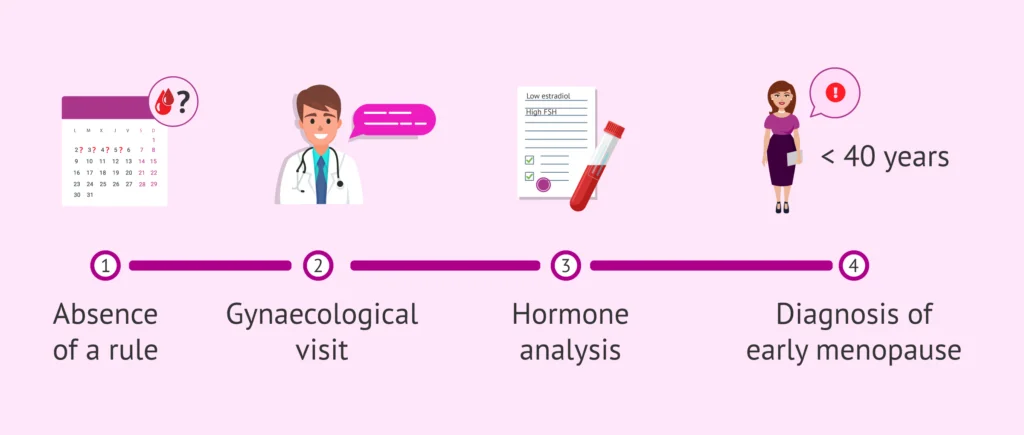Menopause is a natural biological process that marks the end of a woman’s reproductive years. However, some women may experience menopause earlier than expected, a condition known as early menopause. Early menopause diagnosis is crucial for managing symptoms, preventing complications, and addressing potential underlying health issues. In this blog, we will explore the signs and symptoms of early menopause, the diagnostic process, and strategies for coping with this life transition.
Contents
Understanding Early Menopause

Early menopause, also known as premature or premature ovarian failure, refers to the cessation of menstruation and the decline of ovarian function before the age of 40. This condition occurs when a woman’s ovaries cease to produce an adequate amount of estrogen and eggs, leading to a range of physical and hormonal changes.
Causes of Early Menopause
- Genetic Factors: A family history of early menopause can increase the likelihood of experiencing it. Genetic factors may influence the age at which a woman’s ovaries naturally cease functioning.
- Medical Treatments: Certain medical treatments such as chemotherapy or radiation therapy for cancer can damage the ovaries, leading to premature ovarian failure.
- Autoimmune Disorders: Conditions where the immune system attacks the ovaries, such as autoimmune ovarian insufficiency, can result in early menopause.
- Surgical Interventions: Surgical removal of the ovaries (oophorectomy) or the uterus and ovaries (hysterectomy) can induce early menopause.
- Chromosomal Abnormalities: Conditions such as Turner syndrome, where a woman is born with only one X chromosome, can be associated with early menopause.
Signs and Symptoms of Early Menopause
- Irregular Menstrual Cycles: Changes in the menstrual cycle, including irregular periods or skipped cycles, are common signs of early menopause.
- Hot Flashes and Night Sweats: Sudden feelings of heat, especially in the upper body and face, accompanied by sweating, are classic symptoms of hormonal changes during early menopause.
- Vaginal Dryness: Decreased estrogen levels can lead to vaginal dryness and discomfort during sexual intercourse.
- Mood Swings and Emotional Changes: Hormonal fluctuations can impact mood, causing mood swings, irritability, and an increased susceptibility to stress and anxiety.
- Changes in Libido: Reduced estrogen levels may contribute to a decline in sexual desire and satisfaction.
Early Menopause Diagnosis Methods

Early diagnosis is crucial for understanding and managing the associated changes effectively. Here are the various methods that a healthcare professional can use to diagnose early menopause.
1. Medical History Assessment
Objective: Understanding a woman’s medical history is the first step in diagnosing early menopause.
Process: Healthcare providers inquire about the woman’s menstrual history, including the regularity of her periods, any changes in menstrual flow, and the presence of other symptoms associated with hormonal fluctuations. A detailed family history is also explored, as a genetic predisposition can influence the age at which menopause occurs.
2. Physical Examination
Objective: A physical examination helps assess overall health and may reveal signs indicative of early menopause.
Process: During the physical examination, healthcare professionals may check for physical signs of hormonal changes, such as changes in breast tissue, skin, or hair. They may also perform a pelvic exam to evaluate the health of the reproductive organs.
3. Hormone Testing
Objective: Measuring hormone levels in the blood provides essential data for confirming early menopause.
Process: Blood tests, particularly measuring follicle-stimulating hormone (FSH) and estrogen levels, are commonly employed. In early menopause, FSH levels are often elevated, indicating the body’s attempt to stimulate the ovaries to produce more estrogen. Low estrogen levels are also observed.
4. Anti-Müllerian Hormone (AMH) Testing
Objective: AMH testing provides information about a woman’s ovarian reserve, offering insights into her reproductive potential.
Process: AMH is a hormone produced by small ovarian follicles. Lower AMH levels may indicate diminished ovarian reserve, potentially contributing to early menopause. AMH testing is particularly useful in predicting ovarian function and fertility.
5. Imaging Tests
Objective: Imaging tests help visualize the ovaries and assess their structural and functional status.
Process:
- Ultrasound: Transvaginal ultrasound can help to assess the size and appearance of the ovaries. In early menopause, ovaries may appear smaller than usual.
- MRI (Magnetic Resonance Imaging): MRI can provide detailed images of the reproductive organs, helping identify any structural abnormalities.
6. Genetic Testing
Objective: Genetic testing can identify chromosomal abnormalities or mutations associated with early menopause.
Process: For women with a family history of early menopause or suspected genetic predisposition, genetic testing may be recommended. Conditions such as Turner syndrome or Fragile X syndrome can be identified through genetic testing.
7. Menstrual Cycle Monitoring
Objective: Monitoring menstrual cycles over time helps identify irregularities and patterns associated with early menopause.
Process: Women may be asked to keep a menstrual diary, noting the duration and intensity of periods, as well as the presence of any associated symptoms. This information can contribute to a more comprehensive diagnosis.
8. Other Laboratory Tests
Objective: Additional laboratory tests may be conducted to rule out other potential causes of symptoms.
Process: Tests for thyroid function, autoimmune disorders, and other hormonal imbalances may be performed to ensure that early menopause is the primary cause of symptoms.
How To Get Early Menopause Diagnosis?

Getting an early menopause diagnosis involves consulting a healthcare professional who can assess your symptoms, conduct relevant tests, and provide appropriate guidance. Here’s a step-by-step process to help you navigate the path to an early menopause diagnosis:
1. Select the Right Healthcare Professional: Choose a healthcare provider specializing in women’s health, such as a gynecologist, reproductive endocrinologist, or endocrinologist. If you don’t have a specific specialist, start with your primary care physician who can refer you to an appropriate specialist if necessary. HerMantra is an online platform that provides access to the best healthcare professionals for your help.
2. Schedule an Appointment: Call the healthcare provider’s office and schedule an appointment. Inform the receptionist that you are seeking consultation for concerns related to menopause symptoms or potential early menopause.
3. Prepare for the Appointment: Before the appointment, gather relevant information. Create a list of your symptoms, their duration, and any factors that exacerbate or alleviate them. Additionally, note details about your menstrual history, family history of early menopause, and any other pertinent health information.
4. Attend the Appointment: Arrive at the appointment on time and be prepared to discuss your concerns. Openly communicate your symptoms, emphasizing any changes in your menstrual cycle, hot flashes, night sweats, mood swings, or other relevant issues.
5. Medical History Assessment: The healthcare provider will inquire about your medical history, including any pre-existing conditions, surgeries, medications, and family history. Be thorough and honest in providing this information, as it is crucial for an accurate diagnosis.
Steps After Early Menopause Diagnosis
After receiving an early menopause diagnosis, there are several steps you can take to manage the condition and maintain your overall health and well-being. Here’s a comprehensive guide to the steps you may consider:
1. Understand the Diagnosis: Take the time to understand the implications of the early menopause diagnosis. Discuss the details with your healthcare provider and ask any questions you may have.
2. Discuss Treatment Options: Engage in a thorough discussion with your healthcare provider about potential treatment options. This may include hormone replacement therapy (HRT) or other strategies to manage symptoms and support your health.
3. Educate Yourself: Learn more about early menopause, its causes, and potential effects on your health. Being well-informed can empower you to make decisions about your care and lifestyle.
4. Consider Lifestyle Modifications: Adopt healthy lifestyle habits to manage symptoms and promote overall well-being. This may include maintaining a balanced diet, regular exercise, stress management, and sufficient sleep.
5. Bone Health: Focus on maintaining bone health as early menopause means a higher risk of osteoporosis. Ensure an adequate intake of calcium and vitamin D, and engage in weight-bearing exercises.
6. Emotional Well-being: Acknowledge and address the emotional aspects of early menopause. Seek support from friends, family, or a mental health professional if needed.
7. Discuss Fertility Preservation (if applicable): If fertility is a concern, discuss options for fertility preservation with your healthcare provider. This may involve procedures like egg freezing if you haven’t completed your family planning.
8. Follow-up with Healthcare Provider: Schedule regular follow-up appointments with your healthcare provider to monitor your health and assess the effectiveness of any treatment plans.
9. Adapt to Changes: Recognize and adapt to the physical and hormonal changes associated with early menopause. Be patient with yourself and make adjustments to your lifestyle as needed.
Conclusion
In conclusion, an early menopause diagnosis is a transformative moment requiring understanding and proactive engagement. Empowered by knowledge, women can navigate this journey with tailored healthcare, lifestyle adjustments, and emotional support. It’s an opportunity for self-care, resilience, and informed decision-making, fostering not just physical but emotional well-being. Collaborating with healthcare providers, staying connected, and adapting to changes ensure a holistic approach.
Early menopause, while presenting challenges, unveils avenues for personal growth and well-being, illustrating the strength and adaptability inherent in every woman’s unique story. Embracing this transition, women can chart a course toward a fulfilling and healthy future. If you are facing menopause-related issues, menopause treatment at HerMantra can help. Book your free trial online menopause treatment session now.


